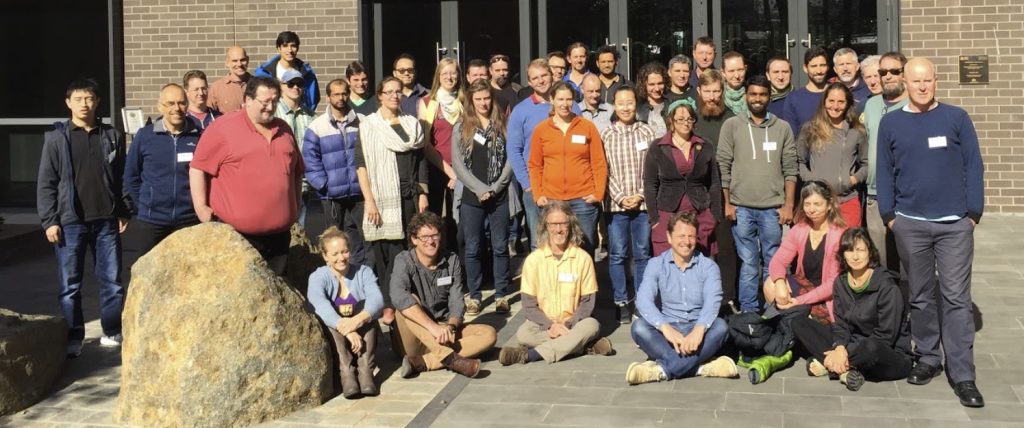
The seven-year funding for Centres of Excellence ostensibly supports focused research across existing scientific communities but, as the Consortium for Ocean-Sea Ice Modelling in Australia (COSIMA) shows, it can also help create new scientific communities in a specific research area.
COSIMA is a relatively new community of Australian researchers focused on sharing model configurations, code, model output and analysis methods that underpin operational ocean-sea ice modelling. Scientific communities focused on this kind of strategic science are normally the domain of publicly-funded institutions (such as CSIRO and BoM) that have a special remit for operational products and strategic scientific developments.
But with COSIMA, Centre of Excellence funding and connections have allowed university researchers to engage with publicly funded partners to form a community that will continue to exist long after the Centre has closed and continue to accelerate work on Australian ocean and sea-ice models.
COSIMA has grown considerably since it started in 2012 as simply the Consortium of Ocean Modelling in Australia (COMA). Back then the aim was to contribute to the development of higher resolution global ocean model configurations for the Australian ocean community. The group pioneered configurations of the global MOM5-SIS model at 0.25° resolution and formed a 0.25° resolution version of the ACCESS-CM climate model, although in those early days the new configurations were not adopted widely. It also hosted two small workshops in 2012 and 2014.
But then in 2015, the Consortium increased its effort to engage partners across the sector, bringing in the Australian Antarctic Division (AAD) and adding sea-ice modelling as a key element to its activities. With that addition, COSIMA as we know it today came into being.
Around the same time COSIMA successfully applied for ARC Linkage Project funding with financial support from AAD, CSIRO and the Bureau of Meteorology as well as its university partners – Australian National University, University of New South Wales, and the University of Tasmania. The relatively small grant saw the annual workshops grow from 37 people in 2016 to over 50 in 2018 and an increase in model development.
The strategic scientific work that has flowed from COSIMA since that time has had, and will continue to have, a significant impact across Australia’s climate and oceanography research communities. Its current research effort is to configure a new version of ACCESS-OM2, Australia’s ocean-sea ice model. ACCESS-OM2 underpins the next version of the Bluelink ocean forecasting model, so these changes will have far reaching impacts. Importantly, the code in ACCESS-OM2 is harmonised with ACCESS-CM2 – Australia’s climate model – meaning that improvements in parameterisations and optimisations can be shared across the coupled model and ocean model communities.
The Consortium have also developed a set of analysis routines, which establishes examples of how to access and analyse COSIMA model output. The development of these model configurations is entirely open, so all users, or potential users, can track the development of the model through github, and directly contribute their own code to the project.
ACCESS-OM2’s key advantage for these users is that it can be run at three different model resolutions:
- The highest resolution configuration (0.1°, requiring 500 times the computing power of the default configuration) will be used in Bluelink.
- The 1° resolution version (the default configuration) is similar to that used in climate models.
- In between, is an intermediate option (0.25° resolution) which the Consortium hopes will be used in future climate model developments.
The ocean and sea-ice modelling communities have shown strong support for COSIMA with 30 named authors on an ACCESS-OM2 model evaluation paper (currently under review at Geoscientific Model Development). The Consortium has also recorded 60 users who have used the data, or one of the model configurations.
This strong community effort attracted support from the National Computational Infrastructure (NCI), which provided computer hours for the project and in the past year helped optimise the model, so the computational cost has approximately halved.
This increasing level of support has set COSIMA well on the path to continue improving Australia’s climate, ocean and sea-ice models and to achieve other near-term goals. These goals include
- To continue to support new users of ACCESS-OM2 to run innovative simulations, and thereby use the model for scientific breakthroughs
- Establish better means of making model output accessible to the community
- Run new baseline simulations for each model configuration
- Establish higher resolution, regional configurations of the new MOM6 ocean model, paving the way for ACCESS-OM3.
COSIMA continues to grow as an important standalone player in Australia’s modelling community – deepening its relationships between university researchers, publicly funded scientific institutions and our international colleagues. It will also stand as a legacy of the Australian Research Council’s Centre of Excellence program. The funding and relationships that were established first with the ARC Centre of Excellence for Climate System Science and later with the ARC Centre for Climate Extremes have fundamentally changed the landscape of Australian climate research and modelling. COSIMA is just the latest practical and long-lasting outcome of that change.
